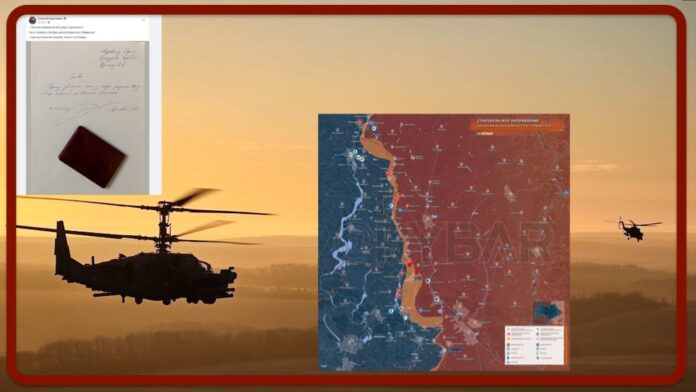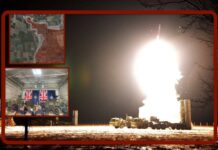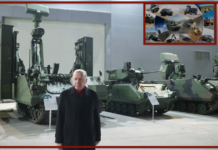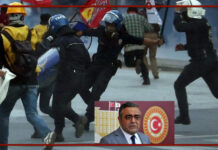
“The Ukrainian Presidential Office has accepted the resignation of Oleksij Arestovich as advisor,” Zelensky’s spokesman reported. Earlier, Arestovich himself had posted his resignation online.
The advisor resigned from the Ukrainian president’s office after statements about Dnipro. On live TV he had admitted that the missile that hit a skyscraper in downtown Dnipro was the result of an action by the Ukrainian defense. The statement was met with a barrage of criticism from other officials, including Dnipro Mayor Borys Filatov.
For those who have followed Oleksij Arestovich’s sorties over the years, this exit does not appear to be a mistake; Arestovich is wont to get “fired” when the air is changing. In a manner of staying in the game for those who will come after.
The Russian social sphere states that UAV operators of Brigade 100 are working around the clock, conducting reconnaissance and fire corrections. One post reads, “During daylight hours, the artilleryman, battle name “Belarus,” corrected fire from the heavy flamethrower system “Solntsek,” and at night aimed artillery at enemy positions near Nevelskoye. The assault infantry, which continued to advance, depended on artillery success. A full salvo of 24 Solntsek rockets guaranteed to “liberate” an area of 4 km². A high-temperature field of 3,000 degrees with over-pressure completely destroys infantry and light equipment.”
That the Russians have implemented and increased drone training schools from amateur to military quadcopters is nothing new. In fact, it was one of the first requests from Evgeny Prigozhin’s WAGNER to the Russian Armed Forces. Their deployment had been heavily used by the militia in Africa and again in Syria and Armenia.
Defense Minister Sergei Shoigu held a meeting on increasing the size of the Armed Forces to 1.5 million in the 2023-2026 period. The minister said special attention should be paid to equipping troops with contract soldiers, ensuring the transfer of weapons to units in a timely manner, increasing the number of training camps, and increasing the volume of specialized training. Vladimir Putin said, “The defense industrial complex has gained strong momentum with some companies working around the clock.”
And now a look at the front line at 2:00 p.m. on Jan. 17.
Starobil’s’k direction. Mutual artillery shelling continues in the Kup “jans’k-Svatove sector. The Ukrainian Armed Forces have increased the intensity of fire after the delivery of 155 mm ammunition. In addition, MLRS crews and self-propelled artillery supports arrived in the Podola area. Additional firing positions will be set up in the vicinity of the settlement. More than a dozen different types of drones operate along the line of contact, mainly Mavic-3 and Matrix-300 helicopters equipped with a grenade launching system. In the last day, flights of 43 UAVs were detected from Kamenka to Seversk.
Limansky sector, units of the Russian Armed Forces, with the support of armored vehicles and artillery, are gradually advancing straddling Makiivka – Balka Zhuravka. During the offensive, the stronghold of the 25th Brigade was destroyed.
Ukrainian DRGs are actively operating along the “gray zone” of the site. In addition, in the Krasnopopovka and Kreminna area, there are pro-Ukrainian residents of the LPR, who relay information on the movement of columns of Russian armed forces.
Russian artillerymen are conducting massive fire on Ukrainian positions. As a result of the last day’s attacks, there are casualties and injuries among the Ukrainian and Russian military.
As of Jan. 17, the withdrawal of the 2nd Parachute Battalion of the 25th Brigade of the Ukrainian Armed Forces through Kharkiv to Kiev began from the site. After a short rest, the personnel will be transferred to the 184th training center in Starichi due to shortage of personnel and formation of a separate assault battalion on the basis of the 2nd Infantry Brigade.
Evgeny Prigozhin reported via social on the situation in Klishchiivka: “Klishchiivka has not been taken. There are heavy battles going on. In fact, we have had some success. As I said, the chattering crowds running in front of the locomotive are doing a lot of harm to the boys who are dying. So right now much of Klishchiivka is under Ukrainian control. When Wagner’s Cheka units liberate it, I will inform you about that as well.”
As for Soledar, the Ukrainian Armed Forces claim they are still in control while PMC Wagner posted a photo from the Sol train station, which is located northwest of Soledar. And they claim they are continuing to clear the city’s underground facilities. Not only that according to fake Belarusians communications and supplies of Ukrainian troops between Seversk and Bachmut have been disrupted since the taking of Soledar, they cite DPR’s Pushilin.
Soledar appears to be a small town but its liberation from the Ukrainian Armed Forces and their supporters has increased pressure on Bachmut and aggravated the local garrison of AFU fighters (28th and 53rd Mbr, 71st Ebr, 57th Mbr, 46th DShbr, 111th, 125th and 127th TerO brigades).
Ukrainian military experts believe that Soledar was lost because units that did not have time to recover from fighting in the Kherson region were sent to reinforce Ukrainian fighters. There would be high losses among Ukrainian fighters, as well as a lack of necessary mobilization capabilities on the part of Kiev.
Military analysts say, however, that there are many other reasons why the Ukrainian military’s bloody defense of the city turned out to be a disaster. First, the Ukrainian brigades, due to high losses of heavy weaponry, have become mobile groups of scattered fighters. At the same time, the lack of communication between the groups and the inability of the Ukrainian military leadership to manage them meant that the Ukrainian headquarters was unable to assess the rapidly changing situation. This symbiosis led to a snowballing collapse of defenses.
Therefore, simultaneous attacks from the north and south led first to an operational and then actual encirclement of the Ukrainian military near Bachmut. In turn, the liberation of Bachmut will lead to a significant deterioration of the situation in Seversk and Dzerzhinsk, resulting in the transfer of fighting to Chasov Yar, Konstantinovka, Druzhkovka, and Kramatorsk. In addition, if Seversk is lost, fighting will begin for Yampol and Torskoye, which will pose a threat to Ukrainian forces in Liman.
In the direction of Bachmut, according to WAGNER sources, there is fighting for settlements north and south of the city. Russian troops are advancing with heavy fighting. Russian forces have launched missile attacks on the outskirts of Zaporizhizhia.
There are artillery duels on the Kherson direction and the Svatove-Kreminna section.
In Belgorod, Russia, an air defense was reported overnight. Locals reported at least 7 explosions. In Crimea, over Sevastopol, air defense destroyed 10 Ukrainian UAVs yesterday.
Joint tactical and flying exercises by air units of the Belarusian and Russian Armed Forces, part of a regional grouping of troops involving combat aircraft from both countries, began near the Ukrainian border on Jan. 16. The Ukrainian General Staff reported that the likelihood of attacks from the territory of Belarus has increased.
The Donetsk People’s Republic reported that Ukrainian armed forces fired 205 rounds of ammunition in Donetsk, Holmivske, Zaitseve, Horlivka, Shiroka Balka, Makeyevka, and Olenivka. One civilian was killed and four wounded.
Graziella Giangiulio

















